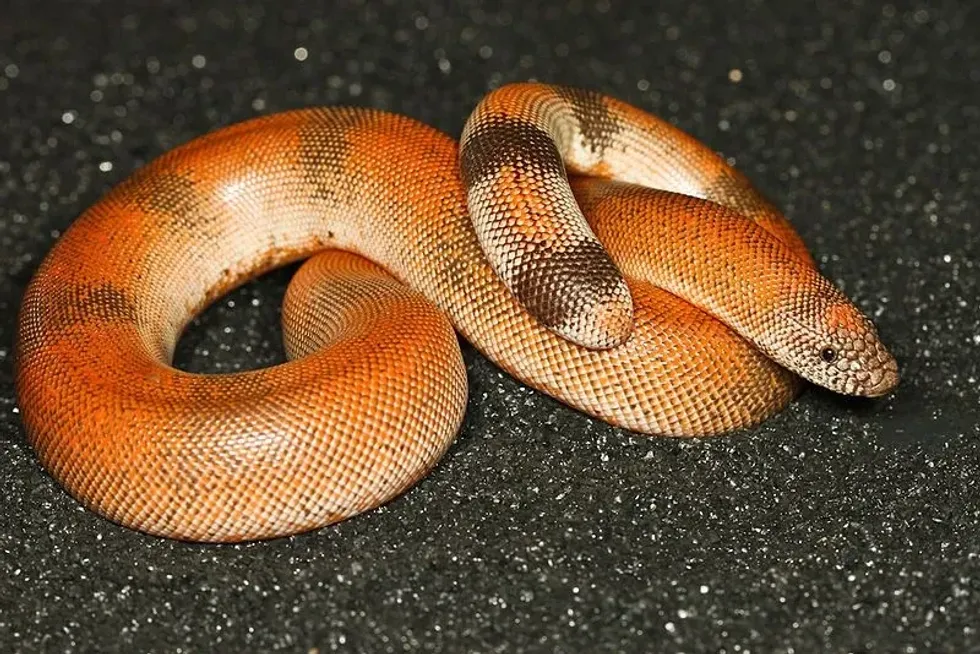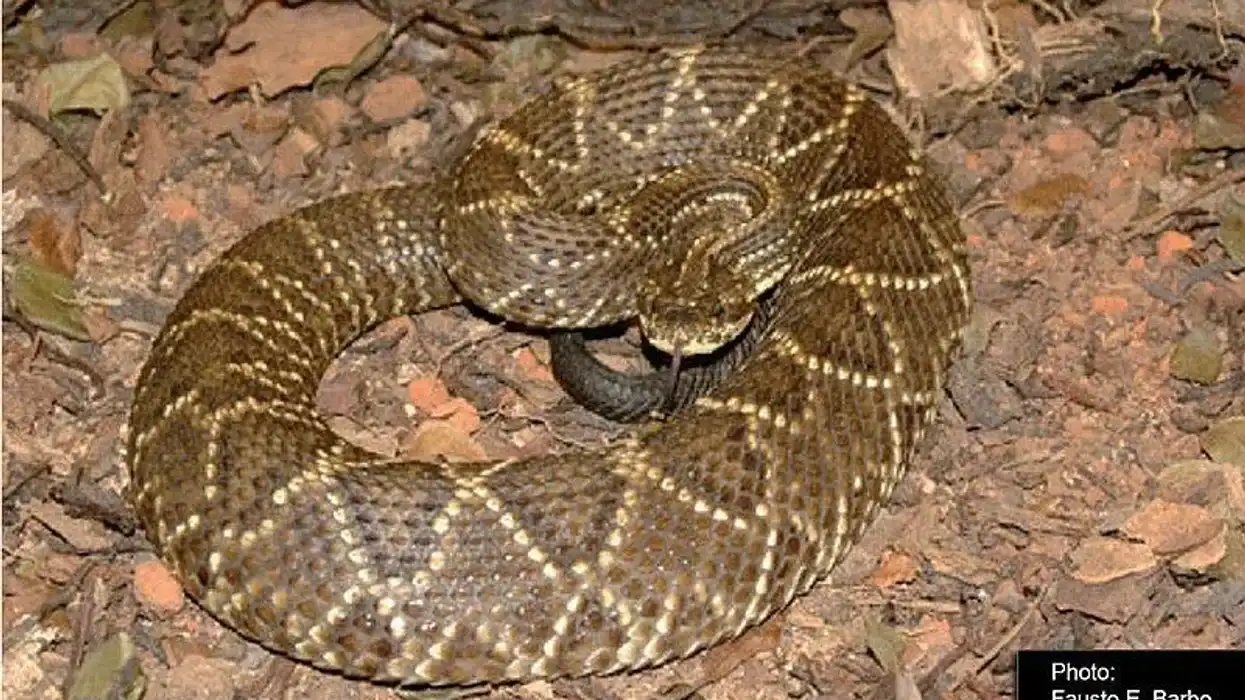The Indian sand boa, Eryx johnii, is a nonvenomous snake species indigenous to south and western Asia. This sand boa is found across Iran, Pakistan, and southern, northwestern, and western India.
It is also commonly known as John's sand boa, Mannoli pambu, Erutaley nagam, brown sand boa, and red sand boa. This rare boa is commonly referred to as the Mandul snake in Maharashtra, a state in western India.
It inhabits rocky dry foothills and dry, semi-desert scrub plains and is adapted to burrowing. It is also known as a two-headed snake as its rounded tail looks similar to its head!
The body of this sand boa is cylindrical-shaped and has polished small dorsal scales. It can have a dull-yellow to reddish-brown coloration and it has small eyes and narrow nostrils on its wedge-shaped head.
It has a short, rounded, blunt tail, similar to its body. It is a carnivorous creature whose diet comprises snakes and mammals like mice, rats, and small rodents.
This two-headed snake faces significant threats due to its distinct appearance. There are many superstitious beliefs attributed to this snake that causes a high level of illegal trade in India to procure it.
Currently, this species of sand boa has not been evaluated by the IUCN. Keep reading to dig deeper into the world of this reptile and learn exciting facts about its behavior, breeding, habitat, and more!
If you found our facts about the Indian sand boa exhilarating, you must read our emerald tree boa fun facts and boa constrictor facts for kids!
Indian Sand Boa Interesting Facts
What type of animal is an Indian sand boa?
The Indian sand boa, Eryx johnii, is a type of snake. It is a species of sand boa that is adapted to burrowing below the surface of the sand. It is a nocturnal snake (active at night) that occurs across Iran, Pakistan, and southern, northwestern, and western India.
What class of animal does an Indian sand boa belong to?
The red sand boa (Eryx johnii) belongs to the class Reptilia, like all other boas.
How many Indian sand boas are there in the world?
The exact population of the red sand boa reptile is currently unavailable. However, we do know that their population is threatened due to illegal trade practices in its regions of occurrence.
Where does an Indian sand boa live?
This sand boa is found across Iran, Pakistan, and southern, northwestern, and western India. It inhabits rocky dry foothills and dry, semi-desert scrub plains and is adapted to burrowing. It is also known to live in the burrows of other animals
What is an Indian sand boa's habitat?
The red sand boa, Eryx johnii, lives underground mostly. It is known to bask underneath the sand's surface for the majority of the day.
Only its head and eyes are partially visible outside, looking out and waiting patiently for potential prey. It emerges out from the ground in the summer season to sunbathe from early to morning until late afternoon.
Who do Indian sand boas live with?
Like all other sand boas, this snake is a solitary creature that only socializes to breed.
How long does an Indian sand boa live?
The lifespan of this sand boa is similar to other sand boas. It can live for 14-20 years.
How do they reproduce?
Indian sand boas are ovoviviparous, and up to 14 young can be in one litter from an adult female Indian sand boa. The young of these sand boas do not receive any nourishment or care from the adults and are completely independent from birth.
What is their conservation status?
Red sand boas have not been evaluated by the IUCN yet. They are protected under the Wildlife Protection Act, 1972.
Their rounded tail looks like their head, making it seem like the snake has two heads. This has resulted in numerous beliefs attributed to these snakes. They are illegally traded for a variety of reasons, like their skin, to attract good luck, and even to cure diseases.
Indian Sand Boa Fun Facts
What do Indian sand boas look like?
The body of this sand boa species is cylindrical-shaped and has polished small dorsal scales. It can have a dull-yellow to reddish-brown coloration. It has small eyes and narrow nostrils on a wedge-shaped head.
It has a short rounded and blunt tail. This tail looks similar to the head, giving this snake a double-headed appearance. There are small, hard scales present on its body to protect the skin of this snake from sand's grit.
How cute are they?
These creatures have a unique appearance that can look scary at first sight, mainly due to their blunt and rounded tail looking like their second head! They are, however, peaceful and calm reptiles that are famous in the exotic pet trade.
How do they communicate?
These sand boas communicate via chemicals called pheromones. They are also known to twitch, jerk, and touch to communicate.
How big is an Indian sand boa?
The average Indian sand boa size is medium when compared to other snakes. Adults range between 1-2 ft (30.4-61 cm) in length. Their range is similar to the adult smooth green snake's length range!
How fast can an Indian sand boa move?
The speed of the Indian sand boa is not known yet. However, sand boas are known to move very slowly at a speed of 1 mph (1.6 kph)!
How much does an Indian sand boa weigh?
The weight of adults ranges between 5.5-6 lb (2.5-2.7 kg).
What are their male and female names of the species?
There are no particular names for male and female snakes.
What would you call a baby Indian sand boa?
The young of the red sand boa can be referred to as a snakelet.
What do they eat?
The diet of these snakes comprises snakes and mammals like mice, rats, and small rodents. Their prey preference helps in reducing the populations of mice and rats in nearby towns and farms. Their predators are not known yet. However, we do know that Kenyan sand boas are preyed upon by desert monitor lizards.
Are they poisonous?
No, these snakes are not poisonous.
Would they make a good pet?
Yes, for some reptile lovers, this snake will make a great pet. Indian sand boa care is relatively easy if you have researched the needs of this snake properly.
Its enclosure must comprise loads of sandy substrate as it burrows in its natural habitat. This snake burrows in loose sand to hide, so therefore, there must be many places for it to hide in its cage.
Did you know...
The 'johnii' part of their binomial name is in honor of Christoph Samuel John, who was a German naturalist.
Do Indian sand boas bite?
The typical Indian sand boa temperament is peaceful and calm, which is why it is availably commonly in the exotic pet trade. It isn't aggressive but it can bite.
Why are sand boas so expensive?
These sand boas are assumed to have two heads. Their tail is rounded and blunt which makes it look like it's two-headed. Without proper documents, these creatures cannot be owned. This makes it very tough for people to procure it, thus their price rises.
These snakes are utilized in the making of cosmetics and medicines too! Due to their huge demand, a red sand boa snake can have a whopping cost of $335,382 in India. They are not illegal here, but ther
Here at Kidadl, we have carefully created lots of interesting family-friendly animal facts for everyone to discover! Learn more about some other reptiles from our cottonmouth snake surprising facts and copperhead snake facts for kids pages!
You can even occupy yourself at home by coloring in one of our free printable sand boa coloring pages!










